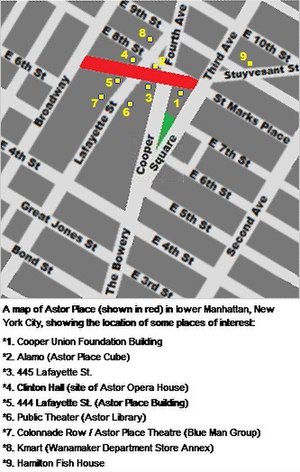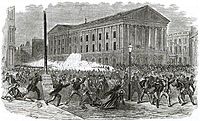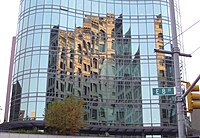Astor Place
40°43′47″N 73°59′29″W / 40.729861°N 73.991434°W

Astor Place is a one-block street in
Geography
The American Guide Series describes the Astor Place district as running from Houston Street north to 14th Street, between Broadway and Third Avenue.[5] The Encyclopedia of New York City defines the neighborhood as between 4th Street and 8th Street, from Broadway to Third Avenue.[1]
History
Astor Place was originally a powwow point for the various Lenape tribes of Manhattan and was called Kintecoying or, “Crossroads of Three Nations".[6]
Astor Place was once known as Art Street. From 1767 through 1859,
Astor Place was the site of the
From 1852 until 1936, Astor Place was the location of Bible House, headquarters of the American Bible Society.[10]
In the mid- to late-19th century, the area was home to many of the wealthiest New Yorkers, including members of the Astor, Vanderbilt, and Delano families. Editor and poet William Cullen Bryant, and inventor and entrepreneur Isaac Singer lived in the neighborhood in the 1880s.[11] By the turn of the century, however, warehouses and manufacturing firms moved in, the elite moved to places such as Murray Hill, and the area fell into disrepair. The neighborhood was revitalized beginning in the late 1960s and 1970s.[1]
The New York City Department of Transportation's "Reconstruction of Astor Place and Cooper Square" plan[3] called for some changes to be made to Astor Place beginning in 2013. The street would end at Lafayette Street rather than continuing east to Third Avenue. This allowed the expansion of the "Alamo Plaza", where the Alamo Cube is located, south to the southern sidewalk of Astor Place between Lafayette Street and Cooper Square, and the creation of an expanded sidewalk north of the Cooper Union Foundation Building. The Astor Place subway entrance plaza was also redesigned, and Fourth Avenue south of East 9th Street and the western part of Cooper Square was converted to be used by buses only, with a new pedestrian plaza created on Cooper Square between East 5th and 6th Streets. The traffic pattern of the area changed significantly, with Astor Place from Lafayette Street to Third Avenue becoming East Eighth Street eastbound, and the formerly bidirectional Cooper Square bus lane becoming northbound-only.[3] The $16 million project[12] was first proposed in 2008, then abandoned and re-proposed in 2011. Construction started in September 2013,[13] and the work was completed in November 2016.[4][14]
Points of interest


The current 299-seat
The trapezium-shaped
Other nearby points of interest include:
- In 1860, Constitution. Cooper Union also housed one of the first free public libraries.
- One of the original libraries making up the Joseph Papp Public Theater.
- The beavers, a tribute to John Jacob Astor, whose fortune was founded in beaver-pelt trading.[19]: 4–5 [20]: 8
- The Peter Cooper Memorial by Augustus Saint Gaudens is one block south on Cooper Square.
- 21 Astor Place (also known as "Clinton Hall" and "13 Astor Place") stands on the site which was once the Astor Place riot, the building was turned over to the New York Mercantile Library, which used it until 1890, when they tore it down and built the current 11-story building. The Library left in 1932, and the building became the headquarters for a union. It has now been redeveloped into modern condominiums behind the original 19th century façade, an example of the technique of facadism.[21]
- The Cooper Station Post Office, built in the 1920s, is just three blocks north.
- The last
Gallery
-
ThePublic Theater
-
The Astor Place riot in 1849: anti-British feelings expressed in a dispute over competing productions of Macbeth; the Astor Opera House is in the background
-
After the riot, the Opera House closed and the building was turned over to the New York Mercantile Library, who later built this 11-story building on the site
-
The Cooper Union Foundation Building has stood on Astor Place, anchoring the north end of Cooper Square, since 1859
-
The Astor Place Building at 444Lafayette Streetwas built in 1876…
-
…while across the street stands the modern condominium building at 445 Lafayette (2004)
-
The beaver in theAstor Place subway station is a tribute to John Jacob Astor, whose fortune was founded on beaver-pelt trading
-
Wanamaker's Department Store
References
- ^ ISBN 0300055366. p.64
- ^ ISBN 978-0-8232-1275-0.
- ^ a b c "Reconstruction of Astor Place and Cooper Square" New York City Department of Transportation (January 6, 2011)
- ^ a b Warerkar, Tanay (November 16, 2016). "Long-awaited Astor Place reconstruction is finally complete". Curbed NY. Retrieved July 18, 2019.
- ISBN 978-1-60354-055-1. (Reprinted by Scholarly Press, 1976; often referred to as WPA Guide to New York City.)
- ^ "Tribes of New York".
- ^ Walsh, Kevin (November 1999). "The Street Necrology of Greenwich Village". Forgotten NY. Retrieved August 17, 2015.
- ISBN 0-8230-0637-9. p.61
- ISBN 0-7432-7478-4. p.138
- ^ Dunlap, David W. (October 21, 2015). "New York Says Farewell to American Bible Society, and Its Building". New York Times. Retrieved October 23, 2015.
- ISBN 978-1-60354-055-1. (Reprinted by Scholarly Press, 1976; often referred to as WPA Guide to New York City.), pp.121–122
- ^ Dailey, Jessica (September 26, 2013). "See Updated Designs For Long-Awaited Astor Place Revamp". Curbed. Retrieved September 9, 2014.
- ^ Dailey, Jessica (September 16, 2013). "Major Astor Place Reconstruction Is Actually Starting". Curbed. Retrieved September 9, 2014.
- ^ "Astor Place Reconstruction Brings 42,000 Square Feet of New Pedestrian Space to the East Village". NYC Department of Design and Construction. Archived from the original on August 12, 2019. Retrieved July 18, 2019.
- ^ a b Moynihan, Colin (November 19, 2005). "The Cube, Restored, Is Back and Turning at Astor Place". The New York Times. Retrieved March 18, 2009.
- ^ Grimes, William (August 1, 2009). "Tony Rosenthal, 94, Sculptor of Public Art". The New York Times. Retrieved July 17, 2010.
- ^ "Astor Place Cube Will Stay in Place". The New York Times. November 23, 1967. p. 33. Retrieved July 17, 2010.
- ^ Bleyer, Jennifer (January 30, 2005). "A Famous Cube Puzzles Its Biggest Fans". The New York Times. Retrieved July 17, 2010.
- ^ "New York MPS Astor Place Subway Station (IRT)". Records of the National Park Service, 1785 - 2006, Series: National Register of Historic Places and National Historic Landmarks Program Records, 2013 - 2017, Box: National Register of Historic Places and National Historic Landmarks Program Records: New York, ID: 75313927. National Archives.
- ^ "Interborough Rapid Transit System, Underground Interior" (PDF). New York City Landmarks Preservation Commission. October 23, 1979. Retrieved November 19, 2019.
- ^ Brozan, Nadine (April 6, 2003). "POSTINGS: On a Triangular Site at 21 Astor Place; 50 Ultramodern Condominiums Behind an Exterior From 1890". The New York Times.
- ^ Offenhartz, Jake (July 12, 2021). "Kmart, An Unlikely Astor Place Icon, Shutters Without Notice". Gothamist. Retrieved July 12, 2021.
- ^ "All that remains of a legendary Astor Place department store few New Yorkers remember". Ephemeral New York. April 10, 2023. Retrieved October 24, 2023.
- ^ "Wegmans officially opens in the East Village". October 18, 2023. Retrieved October 24, 2023.
External links
- Public Theater
- Demolished Broadway theatres
- The Astor Place Riot
- Pictures of the Cube being removed (The Cube was removed on March 8, 2005, restored, then returned on November 18, 2005.)
- Lincoln's Cooper Union Address








